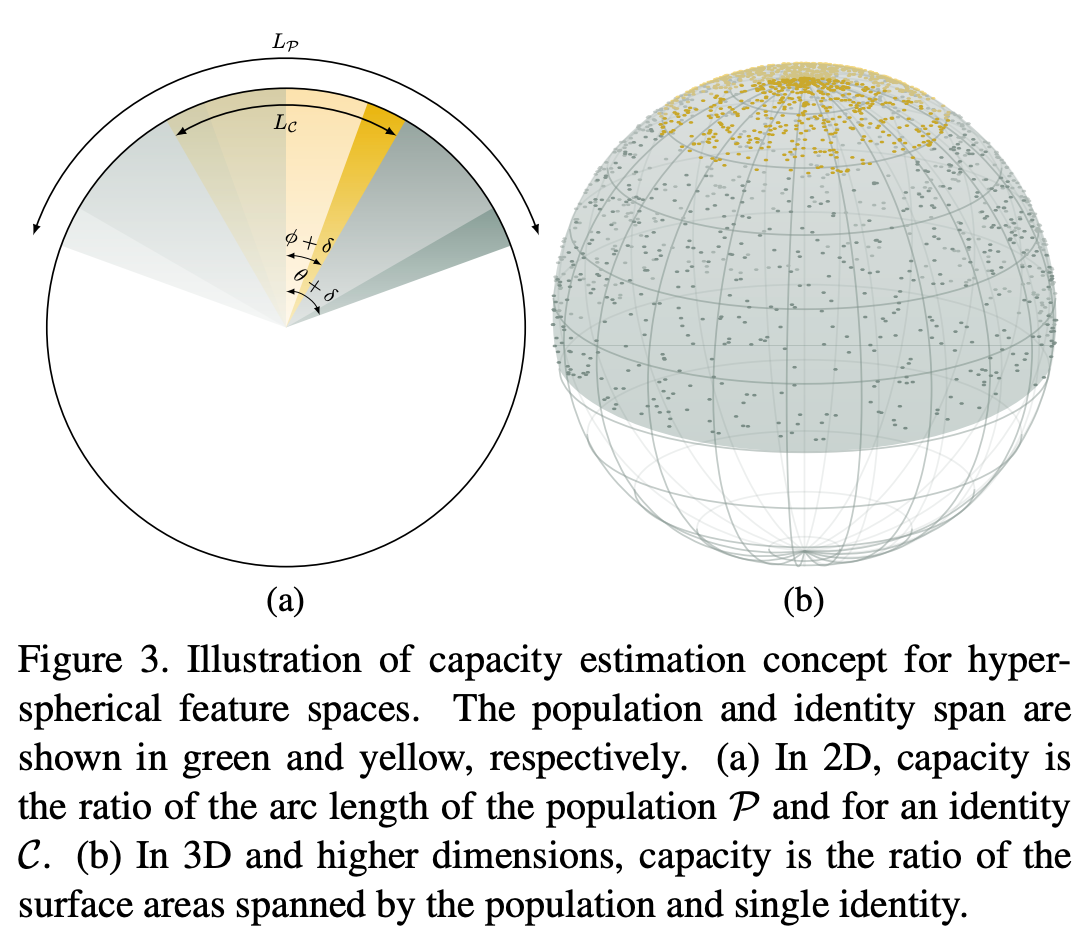On the Biometric Capacity of Generative Face Models [arXiv]
@inproceedings{boddeti2023biometric,
title={On the Biometric Capacity of Generative Face Models},
author={Boddeti, Vishnu Naresh and Sreekumar, Gautam and Ross, Arun},
booktitle={International Joint Conference on Biometrics (IJCB)},
year={2023}
}This work presents the first approach for estimating the biometric capacity of a given generative face model. Capacity is the maximal number of unique identities that a given generative face model can generate.
The idea is to represent the generated face images in a hyperspherical space, i.e.,
We estimate capacity as a ratio of hyper-spherical caps corresponding to all classes (inter-class variance) and a single class (intra-class variance).
For the general case of a
The key challenge here is accurately estimating the inter-class (
Before we proceed, we list the assumptions made by our proposed solution to estimate capacity.
-
We estimate capacity within a feature space such as ArcFace and AdaFace. The capacity estimate is for a combination of a generative model and a feature extractor. However, this is a well-justified choice. First, raw image pixels entangle identity and geometric and photometric variations. Moreover, since we aim to estimate capacity w.r.t. unique identities instead of unique images, we need to calculate capacity in a representation space that preserves identity while being invariant to other factors. Thus, a face recognition system’s feature space is a well-justified representation choice.
-
We estimate the inter-class and intra-class solid angle support from the furthest distance between all the respective samples. So, we inherently assume that the generated samples span the whole representation space within the estimated support. In practice, there may be regions of low feature density, which our approach ignores. Nonetheless, our capacity estimates are upper bounds of the actual capacity and thus still valuable to practitioners and researchers alike.
-
We use a single estimate of the intra-class variance to compute capacity. However, classes typically differ in their intra-class variance due to inherent class properties or the number of samples per class.
git clone https://github.com/human-analysis/capacity-generative-face-models
cd capacity-generative-face-models Create a folder named features and download the features.
mkdir features-
For ArcFace
# PGAN mkdir features/arcface wget -O features/arcface/pggan_celebahq_1024.pkl https://www.dropbox.com/scl/fi/v7zr1mjixna42024tzupv/pggan_celebahq_1024.pkl?rlkey=x0yylm41c0y6xxu3hh4n7ggt5&dl=1 # StyleGAN2-Ensemble wget -O features/arcface/stylegan2-ensem.pkl https://www.dropbox.com/scl/fi/96785gs6txsj0zwc62xh7/stylegan2-ensem.pkl?rlkey=b30fjn5oy4da1iyec1aamllvz&dl=1 # StyleGAN3 wget -O features/arcface/stylegan3.pkl https://www.dropbox.com/scl/fi/k0k76pigzbnat49ktexxf/stylegan3.pkl?rlkey=jsg4s0uxhj15jkovfaxf9mkq5&dl=1 # Latent Diffusion wget -O features/arcface/ldm_celebahq_256.pkl https://www.dropbox.com/scl/fi/qmfz69zo9wiee50yh5r5g/ldm_celebahq_256.pkl?rlkey=58zb255x375k8pif8obec0kzm&dl=1 # Generated.Photos wget -O features/arcface/generated.photos.pkl https://www.dropbox.com/scl/fi/7eiza4e0hxx0rdzewgrbo/generated.photos.pkl?rlkey=lrvik48cjvihnu6k2nr54cxhw&dl=1 # DCFace wget -O features/arcface/dcface_0.5m.pkl https://www.dropbox.com/scl/fi/twe5yjyj5r0zcahg9cy6y/dcface_0.5m.pkl?rlkey=awl795v2lzhorf2qhxdtroxar&dl=1
-
For AdaFace
# PGGAN mkdir features/adaface wget -O features/adaface/pggan_celebahq_1024.pkl https://www.dropbox.com/scl/fi/x2nrg2stu6w7dckyed400/pggan_celebahq_1024.pkl?rlkey=xanxngi06jt7rqhjqks10r73x&dl=1 # StyleGAN2-Ensemble wget -O features/adaface/stylegan2-ensem.pkl https://www.dropbox.com/scl/fi/7gva422lcp2wduzv079ma/stylegan2-ensem.pkl?rlkey=psgzw3hkv2e7fneo82pp69g98&dl=1 # StyleGAN3 wget -O features/adaface/stylegan3.pkl https://www.dropbox.com/scl/fi/9mz8vtnm18d2suzkvudtb/stylegan3.pkl?rlkey=clmnl035o4e24cwa1y1et4trw&dl=1 # Latent Diffusion wget -O features/adaface/ldm_celebahq_256.pkl https://www.dropbox.com/scl/fi/g0sj9x0y7ciwky5zg1tln/ldm_celebahq_256.pkl?rlkey=j42npo4godbm7b61h2umcwkcl&dl=1 # Generated.Photos wget -O features/adaface/generated.photos.pkl https://www.dropbox.com/scl/fi/nkk4zk74n2th97xnc1gbd/generated.photos.pkl?rlkey=8veot2a9gia79eo6vuakbu5s9&dl=1 # DCFace wget -O features/adaface/dcface_0.5m.pkl https://www.dropbox.com/scl/fi/dgkajfrqxbvtad355fqwj/dcface_0.5m.pkl?rlkey=gwcsr4u221d8zgkwk5tcwxs23&dl=1
Download the ARCFace features from the links above for StyleGAN3 and DCFace. The demo notebook demo.ipynb walks you through the capacity estimation process for an unconditional (StyleGAN3) and a class-conditional (DCFace) generator.
To replicate all results from the paper,
- Download all the extracted features from the links above.
- Modify paths, generative model names, feature extractor names etc. in
constants.pyif necessary. - run
python3 main.py
A requirements.txt file has been provided.

